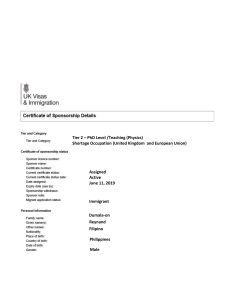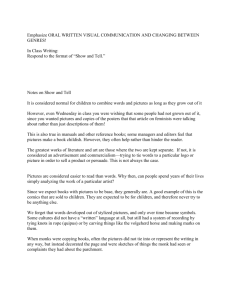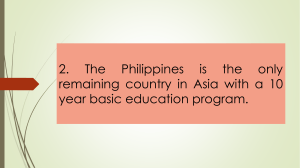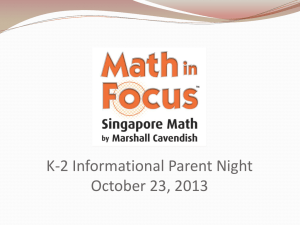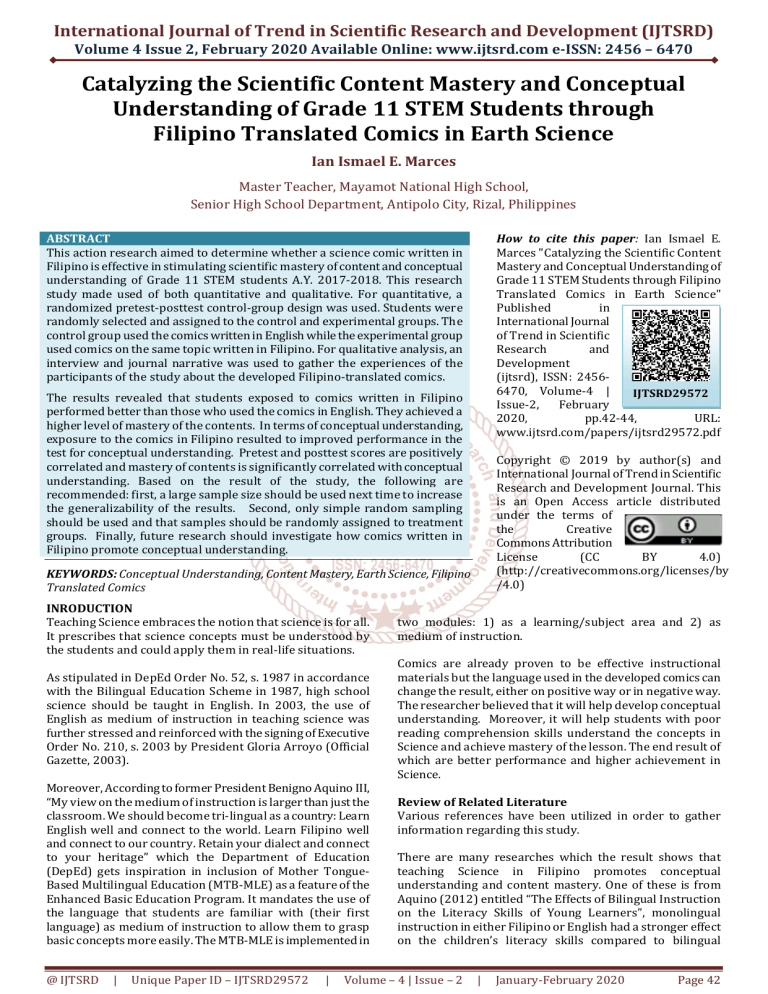
International Journal of Trend in Scientific Research and Development (IJTSRD)
Volume 4 Issue 2, February 2020 Available Online: www.ijtsrd.com e-ISSN: 2456 – 6470
Catalyzing the Scientific Content Mastery and Conceptual
Understanding of Grade 11 STEM Students through
Filipino Translated Comics in Earth Science
Ian Ismael E. Marces
Master Teacher, Mayamot National High School,
Senior High School Department, Antipolo City, Rizal, Philippines
ABSTRACT
This action research aimed to determine whether a science comic written in
Filipino is effective in stimulating scientific mastery of content and conceptual
understanding of Grade 11 STEM students A.Y. 2017-2018. This research
study made used of both quantitative and qualitative. For quantitative, a
randomized pretest-posttest control-group design was used. Students were
randomly selected and assigned to the control and experimental groups. The
control group used the comics written in English while the experimental group
used comics on the same topic written in Filipino. For qualitative analysis, an
interview and journal narrative was used to gather the experiences of the
participants of the study about the developed Filipino-translated comics.
How to cite this paper: Ian Ismael E.
Marces "Catalyzing the Scientific Content
Mastery and Conceptual Understanding of
Grade 11 STEM Students through Filipino
Translated Comics in Earth Science"
Published
in
International Journal
of Trend in Scientific
Research
and
Development
(ijtsrd), ISSN: 24566470, Volume-4 |
IJTSRD29572
Issue-2,
February
2020,
pp.42-44,
URL:
www.ijtsrd.com/papers/ijtsrd29572.pdf
The results revealed that students exposed to comics written in Filipino
performed better than those who used the comics in English. They achieved a
higher level of mastery of the contents. In terms of conceptual understanding,
exposure to the comics in Filipino resulted to improved performance in the
test for conceptual understanding. Pretest and posttest scores are positively
correlated and mastery of contents is significantly correlated with conceptual
understanding. Based on the result of the study, the following are
recommended: first, a large sample size should be used next time to increase
the generalizability of the results. Second, only simple random sampling
should be used and that samples should be randomly assigned to treatment
groups. Finally, future research should investigate how comics written in
Filipino promote conceptual understanding.
Copyright © 2019 by author(s) and
International Journal of Trend in Scientific
Research and Development Journal. This
is an Open Access article distributed
under the terms of
the
Creative
Commons Attribution
License
(CC
BY
4.0)
(http://creativecommons.org/licenses/by
/4.0)
KEYWORDS: Conceptual Understanding, Content Mastery, Earth Science, Filipino
Translated Comics
INRODUCTION
Teaching Science embraces the notion that science is for all.
It prescribes that science concepts must be understood by
the students and could apply them in real-life situations.
two modules: 1) as a learning/subject area and 2) as
medium of instruction.
As stipulated in DepEd Order No. 52, s. 1987 in accordance
with the Bilingual Education Scheme in 1987, high school
science should be taught in English. In 2003, the use of
English as medium of instruction in teaching science was
further stressed and reinforced with the signing of Executive
Order No. 210, s. 2003 by President Gloria Arroyo (Official
Gazette, 2003).
Comics are already proven to be effective instructional
materials but the language used in the developed comics can
change the result, either on positive way or in negative way.
The researcher believed that it will help develop conceptual
understanding. Moreover, it will help students with poor
reading comprehension skills understand the concepts in
Science and achieve mastery of the lesson. The end result of
which are better performance and higher achievement in
Science.
Moreover, According to former President Benigno Aquino III,
“My view on the medium of instruction is larger than just the
classroom. We should become tri-lingual as a country: Learn
English well and connect to the world. Learn Filipino well
and connect to our country. Retain your dialect and connect
to your heritage” which the Department of Education
(DepEd) gets inspiration in inclusion of Mother TongueBased Multilingual Education (MTB-MLE) as a feature of the
Enhanced Basic Education Program. It mandates the use of
the language that students are familiar with (their first
language) as medium of instruction to allow them to grasp
basic concepts more easily. The MTB-MLE is implemented in
@ IJTSRD
|
Unique Paper ID – IJTSRD29572
|
Review of Related Literature
Various references have been utilized in order to gather
information regarding this study.
There are many researches which the result shows that
teaching Science in Filipino promotes conceptual
understanding and content mastery. One of these is from
Aquino (2012) entitled “The Effects of Bilingual Instruction
on the Literacy Skills of Young Learners”, monolingual
instruction in either Filipino or English had a stronger effect
on the children’s literacy skills compared to bilingual
Volume – 4 | Issue – 2
|
January-February 2020
Page 42
International Journal of Trend in Scientific Research and Development (IJTSRD) @ www.ijtsrd.com eISSN: 2456-6470
instruction. Moreover, mother tongue-based instruction, as
compared to second-language instruction, had stronger
effect on the preschoolers’ literacy skills.
In SEAMEO-INNOTECH (2014) project “Translation of Marie
Curie’s Science Lessons in Filipino”. They came up with
“translated lesson plans in poster layout” (p.20). The lesson
plans in poster layout written in Filipino were used during
demonstration lessons and were evaluated by public high
school students in Laguna. Result shows that students
learned the lessons better because the contents of the
posters were written in Filipino.
Moreover, the same result as Reyes (2010) in “Using Filipino
in the Teaching of Science”, two science classes in Grade 4
were taught by the same teacher, one in English and the
other in Filipino. Evaluation scores were better in the class
conducted in Filipino than in that conducted in English. This
suggests that using Filipino in teaching Science would be
more effective than using English. Filipino should therefore
be used as the LOLI for Science in Grade 4.
In addition, Bayo-Ang (2015) on the Effect of Science
Learning Modules on Content Mastery and Conceptual
Understanding of Grade 9 Students, the intervention module
written in Filipino promotes conceptual understanding and
mastery of content than module in English.
Thus, in the research of Calanoga, Cortez, Espartero and
Padilla L (2015) entitled “The Effectiveness of Bilingualism
in Teaching and Learning Process”, the use of Bilingualism as
medium of instruction in teaching is not effective since the
mean gain scores of experimental group is lesser than the
mean gain scores of control group. Furthermore, this implies
that using bilingualism in teaching does contribute good
effect in student’s Engagement and Academic Performance.
Statement of the Problem
This action research aimed to determine whether a science
comic written in Filipino is effective in promoting mastery of
content and conceptual understanding of Grade 11 students.
Specifically, this study answers the following research
questions:
1. Do students who are exposed to science comics written
in Filipino performed better than those who use science
comics in English?
2.
Do students understand the concepts better if they are
written in Filipino than in English?
3.
Is there a significant difference in the pretest and
posttest scores of the experimental and control groups?
4.
Are the pretest scores of the control and experimental
group significantly correlated with their posttest scores?
5.
Are mastery of content and conceptual understanding
significantly correlated?
Scope and Limitation
This action research investigated the effect of Filipino and
English comics on conceptual understanding and mastery of
content of Grade 11 students. It made use of a pretestposttest control group design. Data analysis made use of
descriptive and inferential statistics. This study was
conducted in School Year 2017-2018 and was participated
by Grade 11 students at Mayamot National High School.
@ IJTSRD
|
Unique Paper ID – IJTSRD29572
|
Hypothesis
Students who are exposed to comics written in Filipino
perform better that those who use the comics written in
English. There is a positive correlation between content
mastery and conceptual understanding.
The specific hypotheses are:
1. There is a significant difference in the pretest and
posttest scores of the control group.
2. There is a significant difference in the pretest and
posttest scores of the experimental group.
3. There is a significant difference in the pretest scores of
the control and experimental group.
4. There is a significant difference in the posttest scores of
the control and experimental group.
5. The pretest and posttest scores of the control group are
correlated.
6. The pretest and posttest scores of the experimental
group are correlated.
Methodology and Research Design
This research study made use of both quantitative and
qualitative. For quantitative, a randomized pretest-posttest
control-group design will be used. Students were randomly
selected and assigned to the control and experimental
groups. The control group used the comics written in
English while the experimental group used comics on the
same topic written in Filipino.
Figure 1 shows the research design used in this study. The
‘treatment’ refers to the use of the comics written in Filipino.
Group 1
(Experimental)
O
(Pretest)
Group 2
(Control)
O
(Pretest)
X
(TreatmentFilipino
Comics)
(English
Module)
O’
(Posttest)
O’
(Posttest)
Figure1. Research design
Students who used the English version of comics are
considered the control group because it is a well-known fact
that instructional learning materials in science are written in
English.
After using the Filipino-translated comics, for qualitative
analysis, an interview and journal narrative was used to
gather the experiences of the participants of the study about
the developed Filipino-translated comics.
Results and Discussion
Content Mastery
Analysis of content mastery scores using t-test for
independent samples assuming equal variances revealed
that there is a significant difference in the mean score of the
control and experimental group, t(46) = -2.14, p<.05. Since
the mean score of the experimental group (x =101.9) is
higher than the control group ( x=87.90).
Therefore, students who were exposed to the comics written
in Filipino performed better than those who used the comics
in English. Moreover, the comics in Filipino promote content
mastery better than the comics in English.
Volume – 4 | Issue – 2
|
January-February 2020
Page 43
International Journal of Trend in Scientific Research and Development (IJTSRD) @ www.ijtsrd.com eISSN: 2456-6470
Conceptual Understanding
Analysis of the pretest and posttest scores of the control
group using paired t-test showed no significant difference,
t(18),= 1.44, p>.05, indicating that exposure to the comics
written in English did not improve their conceptual
understanding. It indicates that the English language hinders
understanding of the concepts.
Similarly, paired t-test of the pretest and posttest scores in
the test for conceptual understanding of the experimental
group showed that there is a significant difference between
the pretest and posttest scores t(29) = -5.08,p<.05, indicating
exposure to the comics in Filipino enhanced conceptual
understanding of the learners with observed difficulty in
reading and comprehension of the English texts.
Analysis of posttest scores of control and experimental
group using independent-samples t-test revealed that there
is no significant difference in the scores for control (M=7.3,
SD=2.70) and experimental group (M=8.5, SD=2.58); t
(42)=1.67, p>.05, implying that both groups performed
equally in the conceptual understanding. This indicates that
the performance of the two groups in the test for conceptual
understanding is the same. However, within-subjects
comparison favors the experimental group suggesting that
the comics written in Filipino helped those with reading and
comprehension
problem
achieved
conceptual
understanding.
Correlation Between Pretest and Posttest Scores
The pretest and posttest scores of the control group are
significantly correlated, r (17) = .58, p<.01. Similarly, the
pretest and posttest scores of the experimental group are
also significantly correlated, r (28) = .66, p,<.000. A positive
linear relationship exists between test scores in both groups
with the experimental group slightly higher. A student who
performed well in the pretest will also perform well in the
posttest.
Correlation between Content Mastery and Conceptual
Understanding
Posttest scores in content mastery and conceptual
understanding of the control group are not significantly
correlated, r (17) =.307, p>.05. However, for the
experimental group, they are significantly correlated, r (27)
=.571, p<.05. It means that for the control group, mastery of
contents using the comics in English will not help learners
acquire conceptual understanding. However, it is opposite in
experimental group. Mastery of concepts led to conceptual
understanding.
Conclusion
Students exposed to comics written in Filipino performed
better than those who used the comics in English. They
achieved a higher level of mastery of the contents. In terms
of conceptual understanding, exposure to the comics in
Filipino resulted to improved performance in the test for
conceptual understanding. Pretest and posttest scores are
positively correlated and mastery of contents is significantly
correlated with conceptual understanding.
@ IJTSRD
|
Unique Paper ID – IJTSRD29572
|
Recommendations
Based on the result of the study, the following are
recommended: first, a large sample size should be used next
time to increase the generalizability of the results. Second,
only simple random sampling should be used and that
samples should be randomly assigned to treatment groups.
Finally, future research should investigate how comics
written in Filipino promote conceptual understanding.
References
[1] Aquino, L. (2012). The Effects of Bilingual Instruction
on the Literacy Skills of Young Learners. Retrieved
from https://blog.nus.edu.sg/eltwo/2012/0 6/14/theeffects-of-bilingual-instruc tion-on-the-literacy-skillsof- young- learners-2/
[2] Balce, M. (2005). Teaching Quality Science Education in
Filipino. University of the Philippines, National
Institute for Science and Mathematics Education
Development (UP-NISMED).
Retrieved from
https://mlephil.wordpress.com/2010/02/26/teaching
- quality-science-education-in-filipino/
[3] Banchero, S. (2011). Students Score Poorly on
Science
Test.
Retrieved
from
http://www.wsj.com/articles/SB1000142405274870
4698004576103940087329966
[4] Bayo-Ang, R. (2015). Effect of Science Learning
Modules on Content Mastery and Conceptual
Understanding of Grade 9 Students
[5] Calanoga S. Cortez F. Espartero W. and Padilla L.
(2015). The Effectiveness of Bilingualism in Teaching
and
Learning
Process.
Retrieved
from
http://www.academia.edu/8499465/The_Effectivenes
s_of_Bilingualism_in_Teaching_and_Learning_Process
[6] DEPED. (2012). Mother Tongue Based - Multilingual
Education.
Retrieved
from
http://www.deped.gov.ph/sites/default/files/Final%2
0Mother%20Tongue%20Grades%2013%2001.21.20
14_.pdf
[7] Macapagal, A. (2003). Official Gazette Executive Order
No. 210, s. 2003. Retrieved from http://www.gov.ph/
2003/05/17/executive-order-no-210-s-2003/
[8] Reyes, R. (2010). Using Filipino in the Teaching of
Science.
Retrieved
from
https://mlephil.wordpress.com/ 2010/02/26/usingfilipino-in-the-teaching-of-science/
[9] SEAMEO-INNOTECH. (2014). Translation of Marie
Curie’s Science Lessons in Filipino. Retrieved from
http://www.seameo-innotech.org/wpcontent/uploads/2014/05/MarieCurie_finalreport_23
May20
Volume – 4 | Issue – 2
|
January-February 2020
Page 44

